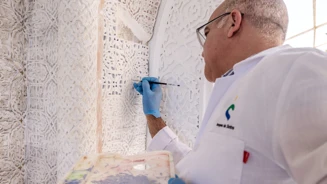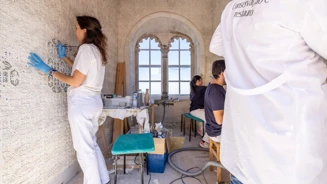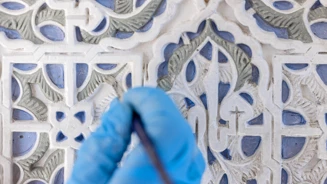Parques de Sintra restores the Arabic Cabinet of the National Palace of Pena
20 Aug 2025
At the National Palace of Pena, Parques de Sintra is carrying out restoration work on the Arabic Cabinet, focusing on the stucco covering and the wooden and metal window frames. The aim of the intervention is to restore the damaged elements, caused both by the wear and tear of time and by the harsh weather conditions, to which the Palace is particularly exposed due to its location at the top of the Sintra hills.
In terms of the covering, the work consists of replacing the degraded stucco panels and restoring their chromatic integration — a meticulous process, considering the state of preservation of the polychromy and the particular characteristics of the raised stucco.
Initially, a preliminary technical study was conducted, focusing on the material characterization and the assessment of the state of preservation, which allowed for the establishment of a well-founded conservation and restoration intervention programme. Through the examination and analysis campaign carried out, it was possible to determine that the colours originally applied to the covering were blue (background) and green (vegetal elements). These tests also confirmed that the original colours corresponded to oil-based paints, as opposed to the mineral-based paints used in the 20th-century restoration campaigns. These conclusions enabled the definition of the type of paint and the colour scheme to be applied in the intervention, promoting both the restoration of the original colour palette and the use of materials compatible with those used in the original decoration of the space.
Given its condition, the conservation and restoration work on the stucco involves not only the treatment and reintegration of the existing covering but also the repair of areas with gaps and the replacement of irreparable panels, which required the execution of silicone moulds and the production of new panels for application during the intervention.
The treatment of the window frames required, in the case of the interior metal window, the removal and reapplication of the element for corrosion treatment and stabilisation. In this context, it was necessary to carry out structural stabilisation, using welding where needed, as well as restoring the fastening system to the masonry, which had been weakened due to the corrosion of the original fastening elements. The wooden window frames — the door leading to the Queen’s Terrace and the exterior window — were treated both structurally and superficially to restore their full functionality and aesthetics.
The Arabic Cabinet is located next to the Queen’s Terrace, on the third floor of the turret attached to the southeast corner of the former monastery complex, from which the Palace of Pena was constructed in the 19th century under the initiative of King Ferdinand II. Architecturally, the main attraction of this room is its unusual covering of raised stucco panels featuring Arabesque motifs, which originally displayed a decorative colour scheme, particularly on the backgrounds and vegetal elements.
Although there are several rooms in the Palace whose fernandine decoration, particularly in painting and stucco, has a concrete relationship with Arab or Moorish styles, this is the only room that, since its construction, directly refers to the world of exotica through its name. The space, accessible only from the terrace, is comparable to garden pavilions intended for refuge and contemplation — the first structures to be the subject of revivalist and exoticising experiences in the 18th century.
The small dimensions of the Arabic Cabinet and the richness of its ornamental stucco contribute to making it a sort of small jewellery box, offering moments of isolation, reconnection, and escape, in line with romantic ambitions or longings.
The restoration work in this room of the National Palace of Pena is expected to continue until the end of September this year.



